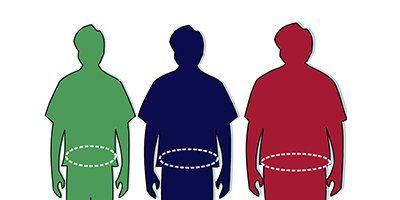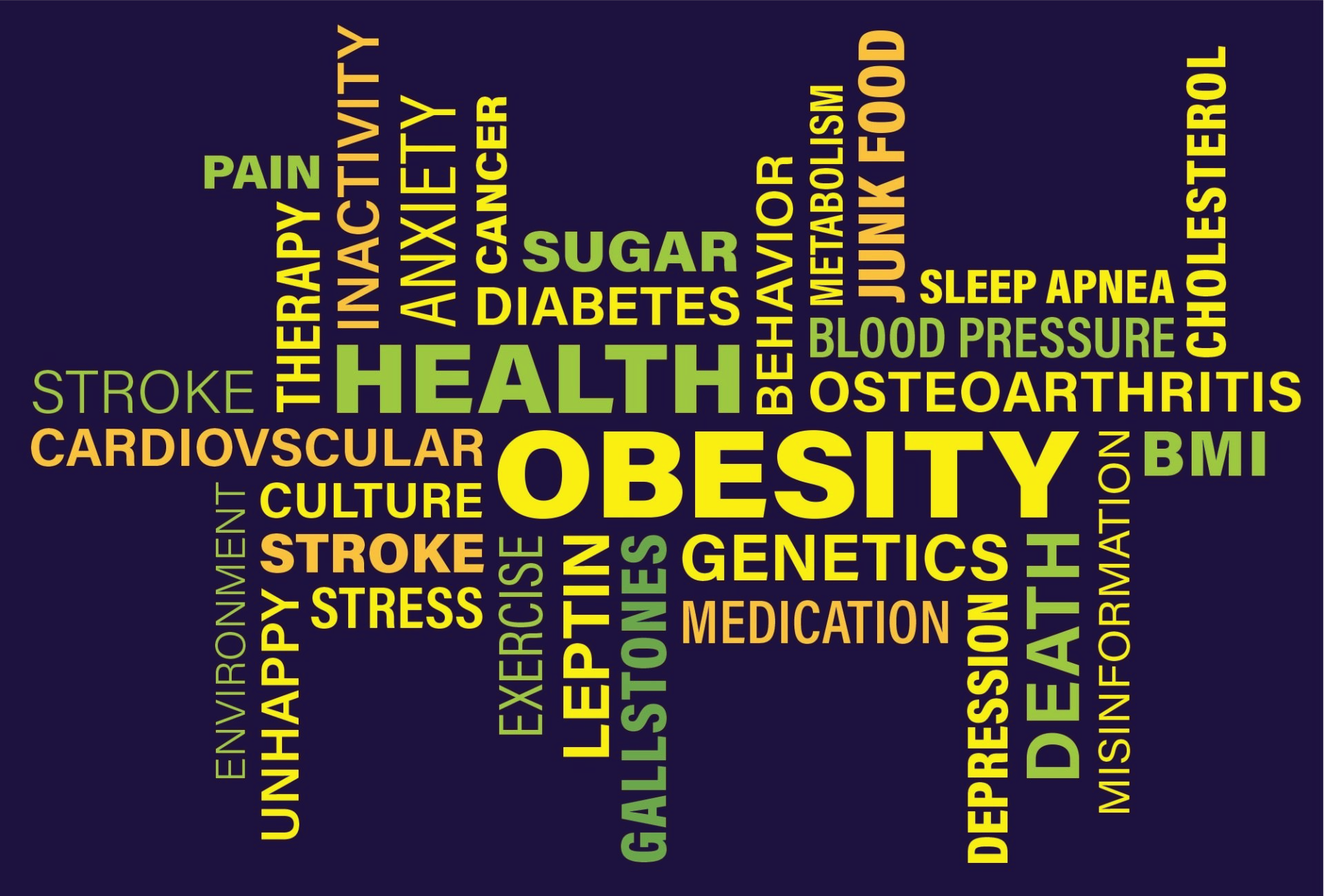OBESITY: ARTICLE Facts About Obesity
by ACTION
Fact Sheet - Obesity is preventable
Illustration of obesity and waist circumference. From left to right, as labeled in the original image, the "healthy" man has a 33 inch (84 cm) waist, the "overweight" man a 45 inch (114 cm) waist, and the "obese" man a 60 inch (152 cm) waist.
Obesity rates are rapidly increasing in the African Region, as in most parts of the world. Overweight and obesity, particularly in urban settings, are major risk factors for type 2 diabetes, high blood pressure, heart attacks and a variety of cancers.
There is a common misconception that obesity and other noncommunicable diseases (NCDs) only occur among the wealthy. Poorer populations are experiencing high double-burdens of infectious and chronic diseases. Additionally, sub-Saharan women are far more likely to be obese than men affecting women’s health issues, pregnancy, maternal and infant health.
The greatest risk factors for dying of NCDs are complications with infectious diseases such as HIV, tuberculosis, streptococcus, human Papilloma virus, viral hepatitis, rubella and parasitic diseases such as malaria.
Obesity is affected by many factors including food choices, sedentary lifestyles, genetics and cultural beliefs. Counterproductively, many countries in the Region view obesity as a sign of prosperity. Sedentary lifestyles are affected by changing modes of transportation, types of work and increasing rates of urbanisation.
Obesity is preventable
- Worldwide obesity has more than doubled since 1980.
- In 2014, more than 1.9 billion adults, 18 years and older, were overweight. Of these over 600 million were obese.
- 39% of adults aged 18 years and over were overweight in 2014, and 13% were obese.
- Most of the world's population live in countries where overweight and obesity kills more people than underweight.
- 41 million children under the age of 5 were overweight or obese in 2014.
FAQs
- What are Overweight and Obesity?
Overweight and obesity are defined as abnormal or excessive fat accumulation that may impair health.
Body mass index (BMI) is a simple index of weight-for-height that is commonly used to classify overweight and obesity in adults. It is defined as a person's weight in kilograms divided by the square of his height in meters (kg/m2).
Adults
For adults, WHO defines overweight and obesity as follows:
overweight is a BMI greater than or equal to 25; and
obesity is a BMI greater than or equal to 30.
BMI provides the most useful population-level measure of overweight and obesity as it is the same for both sexes and for all ages of adults. However, it should be considered a rough guide because it may not correspond to the same degree of fatness in different individuals.
For children, age needs to be considered when defining overweight and obesity.
Children under 5 years of age
For children under 5 years of age:
overweight is weight-for-height greater than 2 standard deviations above WHO Child Growth Standards median; and
obesity is weight-for-height greater than 3 standard deviations above the WHO Child Growth Standards median.
Charts and tables: WHO child growth standards for children aged under 5 years
Children aged between 5–19 years
Overweight and obesity are defined as follows for children aged between 5–19 years:
overweight is BMI-for-age greater than 1 standard deviation above the WHO Growth Reference median; and
obesity is greater than 2 standard deviations above the WHO Growth Reference median.
Charts and tables: WHO growth reference for children aged between 5–19 years
- Facts about Overweight and Obesity
Some recent WHO global estimates follow.
In 2014, more than 1.9 billion adults aged 18 years and older were overweight. Of these over 600 million adults were obese.
Overall, about 13% of the world’s adult population (11% of men and 15% of women) were obese in 2014.
In 2014, 39% of adults aged 18 years and over (38% of men and 40% of women) were overweight.
The worldwide prevalence of obesity more than doubled between 1980 and 2014.
In 2014, an estimated 41 million children under the age of 5 years were overweight or obese. Once considered a high-income country problem, overweight and obesity are now on the rise in low- and middle-income countries, particularly in urban settings. In Africa, the number of children who are overweight or obese has nearly doubled from 5.4 million in 1990 to 10.6 million in 2014. Nearly half of the children under 5 who were overweight or obese in 2014 lived in Asia.
Overweight and obesity are linked to more deaths worldwide than underweight. Globally there are more people who are obese than underweight – this occurs in every region except parts of sub-Saharan Africa and Asia. Some recent WHO global estimates follow.
In 2014, more than 1.9 billion adults aged 18 years and older were overweight. Of these over 600 million adults were obese.
Overall, about 13% of the world’s adult population (11% of men and 15% of women) were obese in 2014.
In 2014, 39% of adults aged 18 years and over (38% of men and 40% of women) were overweight.
The worldwide prevalence of obesity more than doubled between 1980 and 2014.
In 2014, an estimated 41 million children under the age of 5 years were overweight or obese. Once considered a high-income country problem, overweight and obesity are now on the rise in low- and middle-income countries, particularly in urban settings. In Africa, the number of children who are overweight or obese has nearly doubled from 5.4 million in 1990 to 10.6 million in 2014. Nearly half of the children under 5 who were overweight or obese in 2014 lived in Asia.
Overweight and obesity are linked to more deaths worldwide than underweight. Globally there are more people who are obese than underweight – this occurs in every region except parts of sub-Saharan Africa and Asia.
- What causes Overweight and Obesity?
The fundamental cause of obesity and overweight is an energy imbalance between calories consumed and calories expended. Globally, there has been:
an increased intake of energy-dense foods that are high in fat; and
an increase in physical inactivity due to the increasingly sedentary nature of many forms of work, changing modes of transportation, and increasing urbanization.
Changes in dietary and physical activity patterns are often the result of environmental and societal changes associated with the development and lack of supportive policies in sectors such as health, agriculture, transport, urban planning, environment, food processing, distribution, marketing, and education.
- What are common health consequences of Overweight and Obesity?
Raised BMI is a major risk factor for non-communicable diseases such as:
cardiovascular diseases (mainly heart disease and stroke), which were the leading cause of death in 2012; diabetes; musculoskeletal disorders (especially osteoarthritis – a highly disabling degenerative disease of the joints);
some cancers (including endometrial, breast, ovarian, prostate, liver, gallbladder, kidney, and colon).
The risk for these noncommunicable diseases increases, with increases in BMI.
Childhood obesity is associated with a higher chance of obesity, premature death and disability in adulthood. But in addition to increased future risks, obese children experience breathing difficulties, increased risk of fractures, hypertension, early markers of cardiovascular disease, insulin resistance and psychological effects.
- Facing a double burden of disease
Many low- and middle-income countries are now facing a "double burden" of disease.
While these countries continue to deal with the problems of infectious diseases and undernutrition, they are also experiencing a rapid upsurge in noncommunicable disease risk factors such as obesity and overweight, particularly in urban settings.
It is not uncommon to find undernutrition and obesity co-existing within the same country, the same community and the same household.
Children in low- and middle-income countries are more vulnerable to inadequate prenatal, infant, and young child nutrition. At the same time, these children are exposed to high-fat, high-sugar, high-salt, energy-dense, and micronutrient-poor foods, which tend to be lower in cost but also lower in nutrient quality. These dietary patterns, in conjunction with lower levels of physical activity, result in sharp increases in childhood obesity while undernutrition issues remain unsolved.
- How can overweight and obesity be reduced?
Overweight and obesity, as well as their related noncommunicable diseases, are largely preventable. Supportive environments and communities are fundamental in shaping people’s choices, by making the choice of healthier foods and regular physical activity the easiest choice (the choice that is the most accessible, available, and affordable), and therefore preventing overweight and obesity.
At the individual level, people can:
limit energy intake from total fats and sugars;
increase consumption of fruit and vegetables, as well as legumes, whole grains, and nuts; and
engage in regular physical activity (60 minutes a day for children and 150 minutes spread through the week for adults).
Individual responsibility can only have its full effect where people have access to a healthy lifestyle. Therefore, at the societal level, it is important to support individuals in following the recommendations above, through sustained implementation of evidence-based and population-based policies that make regular physical activity and healthier dietary choices available, affordable, and easily accessible to everyone, particularly to the poorest individuals. An example of such a policy is a tax on sugar-sweetened beverages.
The food industry can play a significant role in promoting healthy diets by:
reducing the fat, sugar, and salt content of processed foods;
ensuring that healthy and nutritious choices are available and affordable to all consumers;
restricting marketing of foods high in sugars, salt, and fats, especially those foods aimed at children and teenagers; and ensuring the availability of healthy food choices and supporting regular physical activity practice in the workplace.
- WHO response
Adopted by the World Health Assembly in 2004, the "WHO Global Strategy on Diet, Physical Activity and Health" describes the actions needed to support healthy diets and regular physical activity. The Strategy calls upon all stakeholders to take action at global, regional, and local levels to improve diets and physical activity patterns at the population level.
The Political Declaration of the High-Level Meeting of the United Nations General Assembly on the Prevention and Control of Noncommunicable Diseases of September 2011, recognizes the critical importance of reducing unhealthy diet and physical inactivity. The political declaration commits to advancing the implementation of the "WHO Global Strategy on Diet, Physical Activity and Health", including, where appropriate, through the introduction of policies and actions aimed at promoting healthy diets and increasing physical activity in the entire population.
WHO has also developed the "Global Action Plan for the Prevention and Control of Noncommunicable Diseases 2013-2020" which aims to achieve the commitments of the UN Political Declaration on Noncommunicable diseases (NCDs) which was endorsed by Heads of State and Government in September 2011. The “Global Action Plan” will contribute to progress on 9 global NCD targets to be attained by 2025, including a 25% relative reduction in premature mortality from NCDs by 2025 and a halt in the rise of global obesity to match the rates of 2010.
In 2016 the World Health Assembly welcomed the report of the Commission on Ending Childhood Obesity and its 6 recommendations to address the obesogenic environment and critical periods in the life course to tackle childhood obesity. The Assembly requested the Director-General to develop an implementation plan to guide further action.
More about Obesity & Resent Articles and Events

Obesity rates are rapidly increasing in the African Region, as in most parts of the world.
There is a common misconception that obesity and other noncommunicable diseases (NCDs) only occur among the wealthy.
Strategy for the prevention and control of Obesity in South Africa - 2015 - 2020
Act today for a healthier future. HSF supports the World Obesity Federation (WOF) in the initiative to stimulate and support practical actions to address obesity.
ACTION
African Centre for Obesity Prevention
PARTNERS
Join our growing list of partners, including:
Preventing obesity for a healthier tomorrow
Business Hours
- Mon - Fri
- -
- Sat - Sun
- Closed
About Us
Contact
Office:
+27 10 447 3721
E-mail:






